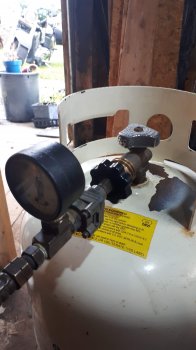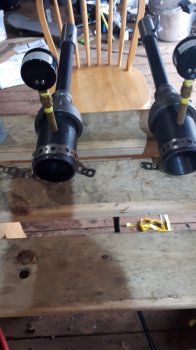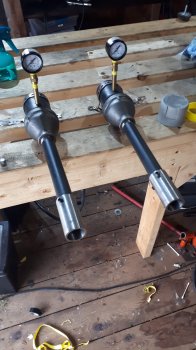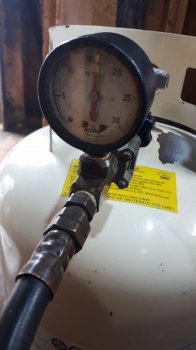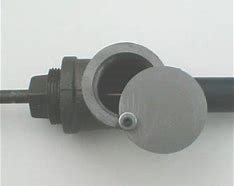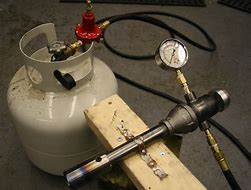I have a question about the blower image...
So this actualy has NO gas orifice, just the 1/4 pipe to the larger pipe?
That IS CORRECT. There is no orifice....just the 1/4" pipe nipple. The key is the propane needle valve.... it's basically the "orifice".
What is the diameter of the larger black pipe and is there anything inside it like a flared nozzel or is that pipe the nozzel as well, and is it flared?
There are two different diameter pipes in that burner. Going from the blower..... a large pipe flange is screwed/attached to a 12" long X 2" black iron pipe. The 2" black iron pipe is screwed/attached to a 2" X 1 1/2" 90 degree elbow. Next is a 1 1/2" X 12" long MINIMUM black iron pipe. (sing that pic, I have change to an 18" length of 1 1/2" there, to improve the burn, and prevent any pre-ignition inside the burner tube. There are no "flares". However, what I do have is concentric pipes inside the forge end of the burner (the 1 1/2" pipe)..... for the last 3" I have a 1" inside the 1 1/2", a 3" piece of 1/2" inside that, and finally a 3" piece of 1/4" inside that. Some folks call it a "flame holder", or whatever, for me it's most important function is to quiet the burner. Without, it literally sounds like a jet engine in the shop.....with it, it's more a gentle roar, and is tolerable, and with ear plugs in barely noticeable.
The two lengths of black pipe attached to the elbow... Does the length and elbow serve a purpose, or can it be a straight shot of pipe. No elbow and plus or minus the overall length?
YES. First, with a blown type burner, It's VERY IMPORTANT that the fuel enter as close to the burner as possible, and on an acute angle (90 degree to the way the pipe runs is about as acute as you can get). Both length and the elbow serve very important purposes..... Over the years I've found that 12" is about as short as you want to go for either piece/size of pipe on a burner of this type. Shorter and problems start occurring...things like poor fuel/air mix, pre-ignition inside the portion of the burner that fits into the forge body, etc. Just suffice to say DO NOT make either piece of pipe shorter then 12", and your life will be much eaiser/nicer.

The elbow is also VERY IMPORTANT..... to explain, lets start at the 1/4" pipe nipple....by placing the pipe nipple an the acute angle (90 degrees to the direction the pipe runs) you've already forced the fuel/air mix to "tumble" some, and there by mix some to begin with. The 90 degree elbow does two things......... first, it forces the fuel/air mix to "tumble", creating a better, more efficient burn. In addition, the fact that the elbow is a "reducer" (going from 2" to 1 1/2") also mean it increase the velocity of the fuel/air mix....which is very important for a strong, efficient burn.
Im just wondering about cost vs efficiency.
There's no question about it....a blown type burner will always be far more efficient then a venturi. That burner runs my welding forge....it's a vertical design, 18" tall, oval shaped with 16" of work area inside (front to back), and 8" side to side inside. The burner runs on 5 psi most of the time. I have a 500 gallon propane tank, dedicated to the forges....and when I am working "full bore", I fill the tank every 16-18 MONTHS.
If I reduce my current set up to a single burner and change the burner as you described, by removing the air throttle cap and pipe extension. Just leaving it as a venturi type.
Assuming I can get it dialed in to where I want it.
MAYBE..... Honestly, those burner you have now are simply a "crap shoot".....you MIGHT be able to get one or more of them to work, and you might not. If you have the time and inclination, give it a try, but my gut tells me that you'd just be wasting time that could be spent forging, if you were to build a simple blown burner.
Would it still be more efficient to go to the blower style?
The cost of the blower and shipping to canada would likely work out to be around $100-150
In my opinion there's no question that a blown burner/forge is FAR more efficient/cost effective then a venturi. Considering size for size, in the same forge body, a venturi burner will usually use roughly 3X more fuel then a blown burner. Even wit the cost you mentioned, it's a bargain because you will be able to use that burner, very likely, for the rest of your life, in just about any forge you decide to build/buy/use. But now we get into your next question........
Pros - cons of venturi vs blower?
I'm gona just say here that for all practical purposes, a blown burner is simply a better choice for most situations. It's generally going to be more initial cost to build, because you buy the blower (and MAKE SURE the blower you buy is intended for forge purposes, and NOT a shade pole/"squirrel cage" type blower). ALWAYS, when building a blown burner....build it for more output then you need. Why? Because once you reach the upper limit of a given burner, your only option then is to build a bigger/higher output burner. With a blow burner, you can always "dial it down"/adjust it down to fit the need....venturi burners not so much.....Venturi burners are usually sized to a specific forge body size/type.....that's why so many folks have difficulty when buying pre-built venturi burners...... and then most times, putting them in forge bodies they were not designed with/for.
Now, all that being said, a venturi burner is a good choice....with a LOT OF IFs......
IF a person needs/wants a burner/forge capable of being used without electricity
IF the venturi is simple in design, and designed for the specific forge body/size it's being use in
IF a person doesn't mind the extra fuel consumption necessary with a venturi
IF........
And finally.... It's worth repeating again....
WHEN IT COMES TO PROPANE FORGES AND BURNERS...... THE "K.I.S.S." PRINCIPLE IS THE MOST IMPORTANT THING YOU CAN KEEP IN MIND! The more you overtake the plumbing....the easier it is to stop up the drain! Over engineering a build is the most common reason that a propane forge fails.
